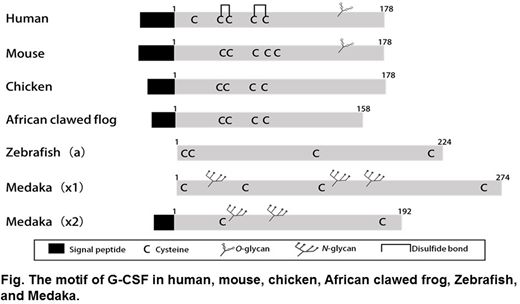Diversity in the repertoires of granulocytes, such as neutrophils, basophils, and eosinophils, has been known among more than seventy thousand vertebrate species. Granulocyte colony-stimulating factor (G-CSF; csf3) affects the differentiation, survival, and proliferation of neutrophils. However, the function of G-CSF in many animal species whose repertoire of granulocytes differs from that of mammals is not clear. We, therefore, attempt to investigate G-CSF function in adult d-rR strain of Medaka fish (Oryzias latipes). Of the three types of granulocytes, Medaka fish possess only neutrophils.
First of all, we assessed the distribution of neutrophils by detecting myeloperoxidase (MPO) -positive cells in the various organs, including the kidney, spleen, heart, liver, and intestine. Among those tissues, the cell proportion of neutrophils was the highest in the kidney (approx. 15%). We then identified the genome sequences of Medaka G-CSFa1x1 and G-CSFa1x2, as orthologs of the mammalian genes encoding G-CSF. They are transcriptional variants and located on chromosome 19. Phylogenetic analysis and locus analysis revealed that these sequences are classified as G-CSFa of teleost fish. The synteny and functional domains of the Medaka G-CSF receptor (G-CSFR; csf3r) is also conserved with those of other species of G-CSFR. They are different from typical mammalian G-CSFs because they have N-linked glycans. We compared the expression of Olcsf3a1 and Olcsf3r in each tissue and found higher expression in the spleen, kidney, and bone of the Medaka fish. The Olcsf3a1x2 expressed much higher than that of Olcsf3a1x1 in the kidney and spleen. In the Medaka exposed to breeding water containing lipopolysaccharide (LPS; Escherichia coli 055: B5), the number of peripheral neutrophils at 3 hours significantly elevated; while that of splenic neutrophils at 3 hours reduced, suggesting that splenic neutrophils were released to the circulation. The expression of Olcsf3a1 mRNA increased at 12 hours after LPS exposure in the bone The number of neutrophils in the kidney increased at 24 hours after LPS exposure, demonstrating that Olcsf3a1 stimulated myelopoiesis shortly after splenic neutrophil release. To elucidate the role of OlG-CSFa1 in a steady-state, we generated the Olcsf3a1 deficient Medaka (G-CSFa1-deficient) by CRISPR/Cas9 genome editing using short guide RNA for the shared sequence of both G-CSFa1x1 and G-CSFa1x2. As we expected, the heterozygous G-CSFa1-deficient Medaka exhibited severe neutropenia. The number of peripheral neutrophils significantly decreased to 1.80×109 cells/L, whereas that of wild-type Medaka was 14.2×109 cells/L. Remarkably, the number of peripheral erythrocytes displayed 2.91×1012 cells/L in the G-CSFa1-deficient Medaka, whereas that of the wild-type Medaka was 5.85×1012 cells/L. We, therefore, tested the gene expressions of hematopoietic growth factors and found that the relative gene expression of erythropoietin decreased in the kidney of G-CSFa1-deficient Medaka.
The results show that G-CSF-deficient Medaka should be a valuable model to examine specific functions of G-CSF in producing granulocytes and its synergistic effect on erythropoiesis.
No relevant conflicts of interest to declare.
Author notes
Asterisk with author names denotes non-ASH members.


